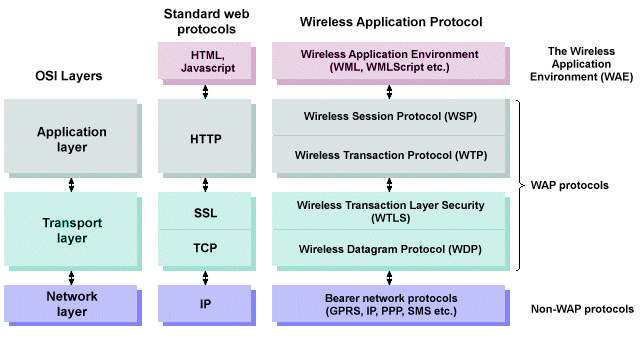Wireless Application Protocol
The Wireless Application Protocol (WAP) is an open standard first developed by the members of the WAP Forum in 1997 for mobile applications in a wireless communications environment. The goal was to develop a technology that would operate over any kind of mobile wireless network, including GSM, CDMA and TDMA-based networks, and 3G technologies such as UMTS. The WAP forum, whose original members included Nokia, Ericsson, Unwired Planet and Motorola, is now part of the Open Mobile Alliance (OMA). The forum’s membership now includes players such as Microsoft, IBM, Oracle and Intel.
WAP technology is primarily designed to enable mobile devices such as mobile phones and personal data assistants (PDAs) to access the World Wide Web and other Internet services such as email, information services and media content. It takes account of the need to optimise the use of the limited bandwidth available to such devices, minimise power requirements, and build in tolerance for the often unpredictable nature of wireless network availability. A micro-browser on the mobile device provides similar functionality to a web browser on a desktop computer, although its capabilities are limited due to the constraints imposed by the architecture of the mobile device (limited display space, processing power and memory). WAP content was originally created using the Wireless Markup Language (WML), an XML-based version of HTML optimised for wireless environment, and hosted on a standard web server. WAP also provided WMLScript, the wireless equivalent of JavaScript.
The original WAP standard was version 1.0, released in 1998. It was closely followed by version 1.1 in 1999 and version1.2 in 2000. These early versions employed a protocol stack that was intended to completely replace the application and transport layer protocols used by the World Wide Web (primarily HTTP and TCP or UDP). The replacement protocols were similar in operation, and provided the same services as their standard counterparts, but were optimised for the constraints of a mobile wireless environment and designed to operate over any bearer network technology as opposed to only IP-based networks. The original WAP protocol stack is illustrated below.

The WAP protocol stack
With version 1.x of the wireless application protocol, a request generated by a mobile device for a WML document will normally be routed via a WAP gateway. The gateway provides the interface between the web server, to which it is connected via the Internet, and the mobile client, to which it connects via the client’s wireless bearer network. It performs the required translation between the WAP protocols used by the client device and the HTTP and TCP/IP protocols used by the web server. It also compresses downstream data (i.e. WML and WMLScript) for transmission across the wireless channel. The micro-browser on the client device decompresses and interprets the resulting byte-code and displays the results on the mobile device’s display. The role of the WAP gateway is illustrated below.

The WAP gateway carries out the necessary protocol translation and content encoding
The WAP 1.x protocols enable communication to take place between the WAP gateway and the micro-browser. They are described below (note that the network layer bearer protocols are not a part of the WAP specification).
- Wireless Session Protocol (WSP) - with WTP, a complete replacement for HTTP, allowing the efficient exchange of data between mobile web applications.
- Wireless Transaction Protocol (WTP) - provides transaction support (reliable request/response) to the datagram service provided by WDP.
- Wireless Transport Layer Security (WTLS) - an optional security layer based on the Secure Sockets Layer (SSL) protocol that provides a secure transport layer connection using encryption.
- Wireless Datagram Protocol (WDP) - a transport layer datagram service like UDP that sends and receives messages via any available bearer network, providing unreliable transport of data. The precise implementation of WDP is dependent on the network layer protocol used by the bearer network, although on IP-based networks it is effectively the same as UDP.
This first version of WAP was not an immediate success in either Europe or North America, although it fared rather better in Japan (possibly due to a more innovative approach to marketing and content provision). Authoring tools for WAP content were not widely available, and the level of support provided by service providers varied considerably. WAP version 2.0 went a long way towards remedying this situation, however, and WAP saw a revival of its fortunes between 2003 and 2004.
WAP version 2.0
The radically re-engineered version of the Wireless Application Protocol was released in 2002 as version 2.0, and essentially replaces the original WAP protocol stack with standard Internet protocols. It does not therefore require a WAP gateway, but a proxy server is often used to optimise communication. A proxy can also improve access times and make more efficient use of network bandwidth by storing copies of frequently accessed resources. Current mobile devices have a much higher specification than the devices in use when WAP first appeared, enabling both HTTP and TCP to be used (although performance is often further enhanced through the use of the wireless profile version of both protocols).
The Wireless Markup Language (WML) has been replaced by XHTML Mobile Profile (XHTML MP), a cut-down version of XHTML. This, together with improved availability of web authoring tools that support XHTML MP, means that it has become easier to create web content that is suitable for mobile devices. The use of HTTP at the application layer has the additional advantage that multimedia content can be sent to a WAP device using the Multimedia Message Service (MMS), which has evolved from the Simple Messaging Service (SMS) used by millions of people every day to send text messages to each other. Another important concept introduced with WAP 2.0 is that of push – a mechanism that allows network servers to initiate the delivery of content to a WAP client device (as opposed to the normal pull model in which the server must wait for a request from the client device).
